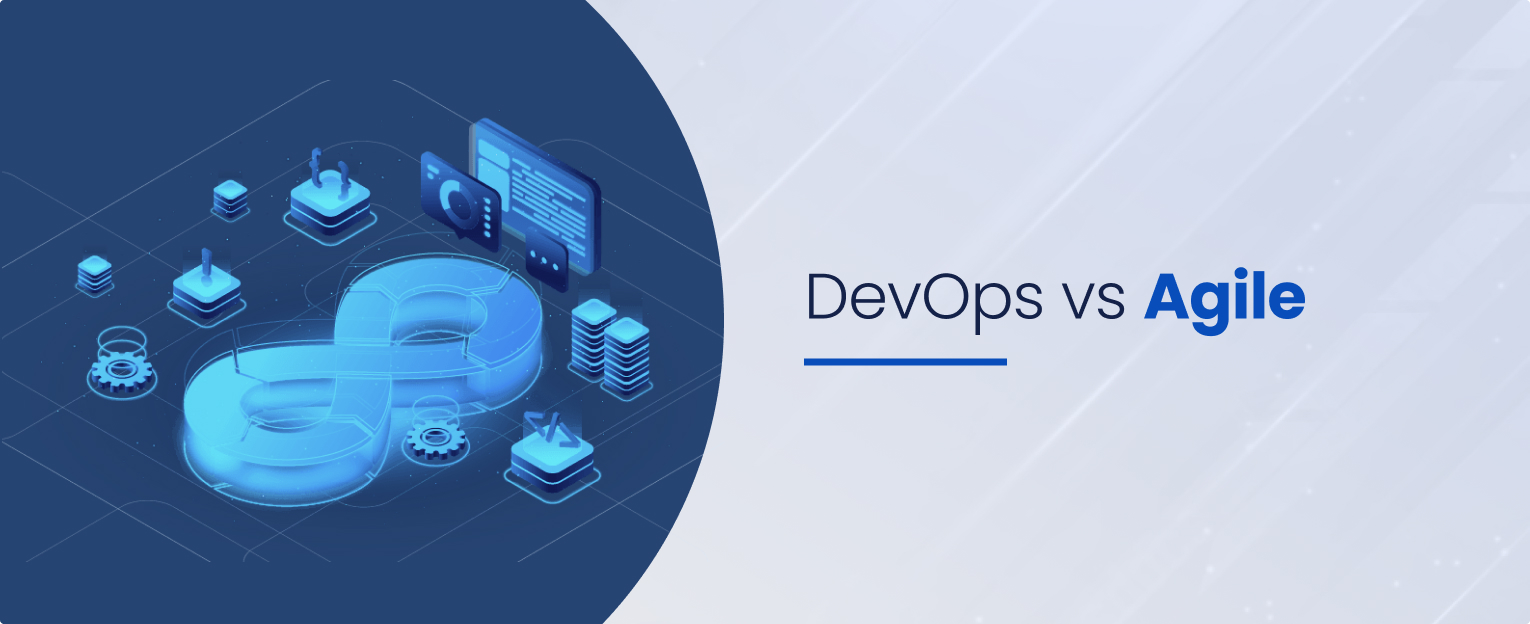Agile and DevOps are two different kinds of software development approaches, yet similar to releasing the finished product as rapidly and effectively as feasible. Even while many businesses are keen to use these techniques, there is frequently some misunderstanding between DevOps cloud computing and Agile. What is covered by each methodology? Where do they cross over? Should you select one over the other or can they coexist?
The primary distinction between DevOps and Agile is that Agile is a development and delivery philosophy, whereas DevOps explains how to continually distribute code using contemporary technologies and automated procedures.
While Agile vs DevOps has many evident contrasts, they also share many characteristics in common. A thorough discussion on the similarities and differences between Agile and DevOps has been discussed in this article.
What is DevOps?
DevOps is a software development approach that seamlessly integrates development and IT operations in a company to boost productivity and promote improved teamwork. DevOps is the combination of people, methods, configuration management tools, and technology that allows reliable, automated code deployment.
The six core philosophies that form the foundation of the DevOps tenets are continuously…
- Integrating,
- Deploying,
- Testing,
- Collaborating,
- Delivering, and
- Operating.
Delivering high-quality software consistently and correctly is its key objective. Deployments that are quicker, more dependable, and simpler to integrate are just a few of the notable advantages of using it and facing DevOps challenges. The acronym “CALMS” for DevOps framework stands for
- Culture refers to the changes an organization’s culture experiences when the operation and development departments work as one.
- Automation means when tasks are made automated for speed and increased quality of the products.
- Lean principles are used in DevOps processes for continuous experimentation and improvements.
- Measurement scales the quality of the product improvements.
Sharing is the reference to the shared responsibility operations and team development teams have for working seamlessly on problems and their solutions.
Service-based DevOps as AWS automates the software deployment process and gives developers the ability to check on the performance of their programs in actual use. With the help of these top AWS DevOps tools, developers adapt their DevOps procedures to suit their particular requirements for devices from various manufacturers.
What is Agile?
Software development practices that adhere to the Agile Manifesto’s tenets include the Agile methodology. It is an iterative strategy for software development and project management that emphasizes fast releases to meet deadlines, customer input to improve quality, and cooperation amongst cross-functional teams to identify answers.
In Agile development processes are divided into smaller, usually two- to one-month-long units called “sprints”; whereas, the Agile approach emphasizes integrating the results of each sprint’s incremental deployments before doing final testing.
The 4 core values formed around the Agile software development methodology are briefly described below.
1. People And Interactions Over Procedures And Equipment
The secret to success while deploying new software is having the correct team of people and encouraging them to communicate and work together to foster a positive work environment and address issues as they emerge.
2. Usable Software Against Thorough Documentation
Agile places a higher focus on delivering software to users than spending excessive time producing documentation rather than generating code and creating the program itself.
3. Prioritize Customer Input Against Contract Negotiations
Agile places a high priority on continuous development and constant client communication as the best approach to guarantee a project’s success.
4. Adapting To Change Vs Sticking To A Plan
The Agile methodology is all about embracing and accepting changes over the course of the project for the benefit of the whole. Agile teams excel at changing direction midstream as opposed to blindly adhering to a strict plan.
DevOps Vs Agile: Key Differences
Let’s examine the Agile vs, DevOps differences in more depth since it is quite the important part of this article.
| Parameters | DevOps | Agile |
| Instituted | DevOps was instituted in the year 2007 as a successor to Agile. | Agile was instituted in the year 2001 as a Waterfall replacement. |
| What They Are | The process of integrating the operations and development teams is known as DevOps. | Agile is a repetitive methodology that emphasizes client input, cooperation, and quick, incremental releases. |
| Purpose | The main goals of DevOps are to manage the whole business and engineering solutions while emphasizing quick delivery. | Agile is used to manage challenging projects and allow for adjustments during project. |
| Focal Point | Continuous testing and quick delivery are done every few hours or even every day and are prioritized. | After each sprint, the Agile approach focuses heavily on incremental deployments and ongoing adjustments. |
| Frameworks | The main focus of Dveops is based on collaborations so it mostly uses, CALMS, DORA and CAMS frameworks. | Agile focuses more on the complexities of projects so it relies more on Sprints, Scrum, Kanban, ScrumBan, Lean, and XP frameworks. |
| Size and Skills of Teams | DevOps relies on the fusion of many teams; therefore, it requires a wider number of individuals with a variety of specialties and operational skill sets to divide responsibilities and accomplish success. | Agile places a strong emphasis on working with a smaller team for quicker execution and risk minimization. Each team member develops a wide range of skills with the help of Agile methodology and becomes an all-around developer. |
| Alternative Tools | The alternative tools for DevOps are Silo-based deployment and development. | The alternative tool for Agile is Waterfall. |
| Tools Used | DevOps uses are AWS, TeamCity OpenStack, Chef, Puppet, and Ansible | Agile uses are Bugzilla, Kanboard, and JIRA. |
| Latency | With significant releases, DevOps aims towards timelines and benchmarks. Delivering code to operation DAILY or every few hours is the ultimate objective | The management of agile development is done through “sprints.” Each sprint takes substantially less time than a month. |
| Report & Review | Reports are provided to the internal staff. | Feedback The customer provides feedback. |
| Targeted Genres | A complete business solution with quick delivery. | Development of software |
| Shift Left Principles | Use both shifts to the left and right. | Utilize shift-left |
| Shortcomings | To speed up work, the DevOps method needs development, testing, and production environments. | Teams must be more productive to use the agile technique, which is challenging to match every time. |
| Benefits | The Agile release cycle is supported. | Agile provides a quicker development cycle and better defect identification. |
| Documentation | The process of documentation is crucial in the DevOps methodology. Automation lessens the effects of inadequate documentation. However, it might be challenging to impart all the necessary expertise when creating complicated software. | The working system is prioritized above exhaustive documentation according to the agile methodology. Being adaptable and responsive is good. When you’re attempting to transfer responsibility to a different team for deployment, it could sting. |
| Hazards vs. Acceleration | The teams using the DevOps methodology must ensure that any modifications to the architecture never pose a danger to the overall project. | Agile teams encourage quick change and a solid application framework. |
| Automation | The main aim of DevOps is automation. It operates under the premise that software deployment should be as efficient as possible. | Automation is not emphasized in Agile. |
| Prominence | The goal of DevOps is to deploy software that is ready for release safely and dependably. | Agile gives software development approaches a lot of attention. The agile team won’t be concerned with what happens to the program once it is created and distributed. |
| Intents | It fills the hole between operations and development + testing. | It closes the gap between development and testing teams and client needs. |
| Commune | Specs and documents for design are shared throughout DevOps conversations. To successfully manage the deployment process, the operational team must have a thorough understanding of the operating system release and its consequences for hardware and networks. | Scrum is the approach to Agile software development that is most widely used. |
| Significance | Implementation, testing, and development are all equally crucial. | Agile inherently involves the creation of software. |
| Multidisciplinary | Operational and development teams are distinct in DevOps. Communication is therefore rather complicated. | The ability to do the duties required for the project’s growth is expected of every team member. Additionally, communication and bonding among team members increase when everyone in the team is capable of performing every duty. |
| Quality | Better quality is produced as a result of early bug eradication, automation, and DevOps. To maintain quality standards, developers must adhere to best practices for coding and architecture. | Better application suites with the appropriate specifications are produced through Agile. It is easily adaptable to modifications that are made on schedule, over the course of the project. |
The Key Takeaways
- While Agile is an iterative strategy that emphasizes cooperation, customer input, and short, quick releases, DevOps is a technique that unites development and operations teams.
- The Agile method focuses on ongoing changes, whereas DevOps emphasizes continuous testing and delivery.
- Agile demands a small team, but DevOps requires a somewhat large team.
- Agile, on the other hand, makes use of the shift-right concept whereas DevOps makes use of both shifts left and right.
- Agile’s focus is on software development, but DevOps’ focus is on end-to-end business solutions and quick turnaround.
- Agile has more of a focus on functional and non-functional preparation than DevOps does on operational and business readiness.
DevOps Vs Agile: Similarities
Organizations need to identify new and creative methods and fixes for problems as the technology is transitioning quite rapidly and the rising customer expectations.
As one is a deliberate development of the other, it is safe to say that the Agile vs DevOps approach shares a great deal in common.
Because the waterfall methodology couldn’t keep up with the demands of the current world, agile was developed. It safely delivers the product after being produced, similar to how DevOps brings the Agile technique full circle and advances.
1. Inspires The Lean Philosophies
Because both DevOps and Agile derive their methodologies from the Lean ideology, they have a lot in common. Both Agile vs DevOps benefit from the standardization of the communication procedures. The Lean principles make these interaction of team members easy, which helps to foster a positive and effective work environment.
2. Prioritize Automation & Testing
Both DevOps vs Agile emphasizes establishing stability. They accomplish it with aggressive working in a quick, safe, and quality-checked atmosphere. Both approaches achieve this with regular integration and a significant amount of testing. They have a similar outlook on the use of automation to increase the execution process’ flexibility and security.
3. Facilitates Effective Team Collaborations
Despite the many Agile and DevOps differences, both emphasize the need of creating a collaborative workplace where team members can communicate and share information to swiftly identify problems and solve them. The importance of interactions between team members is greatly emphasized to increase output, efficiency, and adaptability in Agile DevOps methodology.
4. Enhances Business Productivity
Together, DevOps vs Agile helps organizations maximize business productivity with the help of a strong business-oriented approach. Teams are allowed to focus on a single goal when the Agile technique is used in the process of developing software, allowing them to be more efficient and productive. Incorporating the DevOps culture, on the other hand, results in speedier deployments and delivery times without impairing business procedures.
The Conclusive Thoughts…. Agile and DevOps
DevOps vs Agile helps both aim to increase the effectiveness and standard of software development, therefore discussing one without the other is mostly pointless. While some teams have had great success with agile approaches, others have had difficulty achieving the advantages with the same strategy.
It happens due to a variety of factors, such as teams not appropriately understanding or applying agile techniques. It’s also possible that adding DevOps consulting services will help firms who struggle with Agile fill in the gaps and help achieve the results they hoped for.
- Frequently Asked Questions
Q1. Is DevOps part of Agile?
DevOps can be viewed as an advancement of agile methodologies or as a necessary component of agile. The agile approach’s innovations are being applied to operational procedures in this endeavor.
Q2. Has DevOps replaced Agile?
DevOps is not a substitute for Agile, but a direct inheritor which has emerged as the most effective practice. In the meantime, Agile has experienced growth in its issues through time.














